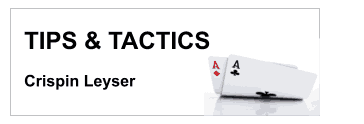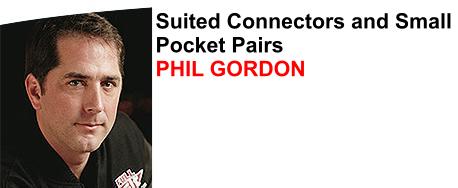
It isn’t easy playing against a super aggressive player. Forgive me for stating the obvious, but I enjoy playing against a player who is weak-passive, into a lot of pots, and just gives me the pots all the time.
Against aggressive players I have to play in a way I’m not necessarily comfortable playing. But a lot of it is just a matter of will. Your will has to be stronger than their will. You have to force them to conform to what’s happening at the table, rather than having them force you to conform.
The best way to fight aggression is with aggression of your own – as long as you’re in the right position. You want the aggressive player to be in front of you. If you have the aggressive player behind you, well, you’re out of luck, because he’ll have position on you most of the time and it’s going to be tough to make the moves.
But let’s assume he’s in front of you. When he opens up in middle position, you can adjust your play based on the fact that he doesn’t necessarily have as good a hand as a more conservative player who just opened up in middle position. If you have a hand like K-Q, you probably wouldn’t play that against a raise from a conservative player. You have to have a stronger hand than what your opponent has in order to play from that position, and K-Q doesn’t quite fit the bill. But against an aggressive player, who could be playing garbage, K-Q becomes a good starting hand.
 You can choose a couple of ways of playing it. You can call and see if you can use your position to beat him after the flop – but because he’s an aggressive player, he might be able to manoeuvre and do things against you. So there’s a simple solution to that: instead of calling, you take a chance and make a decent raise of four times his raise, with the knowledge that (a) you rate to have a better hand, and (b) the aggressive player is not used to having a player re-raise him. Believe it or not, aggressive as they are, they don’t want to play big pots. They want to play small to medium pots, manipulate the pots, and be able to out manoeuvre you. This way you’re telling him, “you aren’t playing a small pot this time, it’s a big one, and now you have to call or come back over the top of me”.
You can choose a couple of ways of playing it. You can call and see if you can use your position to beat him after the flop – but because he’s an aggressive player, he might be able to manoeuvre and do things against you. So there’s a simple solution to that: instead of calling, you take a chance and make a decent raise of four times his raise, with the knowledge that (a) you rate to have a better hand, and (b) the aggressive player is not used to having a player re-raise him. Believe it or not, aggressive as they are, they don’t want to play big pots. They want to play small to medium pots, manipulate the pots, and be able to out manoeuvre you. This way you’re telling him, “you aren’t playing a small pot this time, it’s a big one, and now you have to call or come back over the top of me”.
Now some of the aggressive players, if you do this too much to them, they’re going to say to themselves, “he’s fooling around with me”, and they’re going to take a stand. They are either going to call you, and then do something after the flop, pretend they have a hand; or they’re going to raise right away, and then you have to make up your mind to call or not.
The only consolation I can give is, the aggressive player doesn’t want to get into this. So, if you think he’s a better player than you, that’s what you want to do, you want to make him uncomfortable. You do that a few times to him, and believe me, he’ll stop dead in his tracks.
There’s also a third options, besides calling or putting in a substantial raise, and that’s to put in a small raise. If you do this, the aggressive player will typically re-raise you, and since probably he has a weaker hand than normal for a re-raise, you can now carry it on to the next level and re-raise him. Of course you’re running the risk that this time around, he does have a good hand. Remember, just because an aggressive player raises all the time doesn’t mean when you get into a rising match with him he can’t have aces. He can have aces or kings, and you’re just out of luck.
Again, playing this aggressively isn’t really my style, and I’m not comfortable with it. But as long as I know the other guy is going to be uncomfortable, then that’s fine – I’m willing to suffer through it to force him to suffer through it.
To make matters even worse…
There’s no easy advice for taking on an aggressive player when you’re short stacked. At that point, you just have to pick a hand that maybe you’re not particularly comfortable with – like K-J or A-10 or A-9, and if you figure this aggressive player has a hand that rates to be weaker than that, then you just go all in.
The truth is, at that point, you literally don’t care whether he calls you or throws the hand away. Because if you calls you and he does have a weaker hand, then you’re going to double up your chips. If he has a better hand and he beats you, well, all right, so you’re out of the tournament. When you have a short stack, you’re not giving up as much. People with short stacks don’t have a long future anyway so you might as well gamble.
 Having played at bet365 Poker for years we really enjoy and recommend them highly. bet365 is the lead member of the Playtech iPoker Network.
Having played at bet365 Poker for years we really enjoy and recommend them highly. bet365 is the lead member of the Playtech iPoker Network.
 When you know your hand is no good, even though you have a monster, just throw it away. Listen to your gut and throw those cards in the muck. In the long run, you will come out way ahead simply by getting away from it.
When you know your hand is no good, even though you have a monster, just throw it away. Listen to your gut and throw those cards in the muck. In the long run, you will come out way ahead simply by getting away from it. When playing online tournaments, it never ceases to amaze me how many players get eliminated in the first 5 minutes – often in the first hand!
When playing online tournaments, it never ceases to amaze me how many players get eliminated in the first 5 minutes – often in the first hand! Read more poker tips and advice from professional players
Read more poker tips and advice from professional players Check out the latest poker room reviews and ratings
Check out the latest poker room reviews and ratings

 That said, playing aggressively with a large stack is my personal favourite style of play because you get to play a lot more hands than normal, which keeps the game fun and interesting. It also helps me to pay closer attention because, naturally, if you are playing more hands, you’re going to be more involved (rather than ordering drinks, talking on the phone or watching what’s on TV).
That said, playing aggressively with a large stack is my personal favourite style of play because you get to play a lot more hands than normal, which keeps the game fun and interesting. It also helps me to pay closer attention because, naturally, if you are playing more hands, you’re going to be more involved (rather than ordering drinks, talking on the phone or watching what’s on TV). You don’t have to have aces every time to raise with a big stack. And mixing it up will also allow you to get paid off when you do have big hands. If you occasionally show down J-8(os) or 7-8(s), or even K-2(s) or Q-4, some really funky hands, now they get to thinking, “Does he really have a big hand this time or is he just playing garbage again?” If you play tight, where you’re not really playing many hands, it’s hard to win tournaments, because alarms go off in people’s heads when you do play a hand. You have to give action to get action!
You don’t have to have aces every time to raise with a big stack. And mixing it up will also allow you to get paid off when you do have big hands. If you occasionally show down J-8(os) or 7-8(s), or even K-2(s) or Q-4, some really funky hands, now they get to thinking, “Does he really have a big hand this time or is he just playing garbage again?” If you play tight, where you’re not really playing many hands, it’s hard to win tournaments, because alarms go off in people’s heads when you do play a hand. You have to give action to get action!
 You can choose a couple of ways of playing it. You can call and see if you can use your position to beat him after the flop – but because he’s an aggressive player, he might be able to manoeuvre and do things against you. So there’s a simple solution to that: instead of calling, you take a chance and make a decent raise of four times his raise, with the knowledge that (a) you rate to have a better hand, and (b) the aggressive player is not used to having a player re-raise him. Believe it or not, aggressive as they are, they don’t want to play big pots. They want to play small to medium pots, manipulate the pots, and be able to out manoeuvre you. This way you’re telling him, “you aren’t playing a small pot this time, it’s a big one, and now you have to call or come back over the top of me”.
You can choose a couple of ways of playing it. You can call and see if you can use your position to beat him after the flop – but because he’s an aggressive player, he might be able to manoeuvre and do things against you. So there’s a simple solution to that: instead of calling, you take a chance and make a decent raise of four times his raise, with the knowledge that (a) you rate to have a better hand, and (b) the aggressive player is not used to having a player re-raise him. Believe it or not, aggressive as they are, they don’t want to play big pots. They want to play small to medium pots, manipulate the pots, and be able to out manoeuvre you. This way you’re telling him, “you aren’t playing a small pot this time, it’s a big one, and now you have to call or come back over the top of me”.

 This item continues on from our previous posting “
This item continues on from our previous posting “ When the bubble is approaching, you have to remember that most players are going to get very tight. People might throw away a good hand, like a pair of jacks, or even a pair of queens or A-K.
When the bubble is approaching, you have to remember that most players are going to get very tight. People might throw away a good hand, like a pair of jacks, or even a pair of queens or A-K.